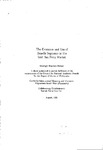The Existence and Use of Benefit Segments in the Irish Sea Ferry Market
| dc.contributor.author | Matear, Sheelagh Maureen | |
| dc.contributor.other | Faculty of Arts, Humanities and Business | en_US |
| dc.date.accessioned | 2013-10-09T12:43:27Z | |
| dc.date.available | 2013-10-09T12:43:27Z | |
| dc.date.issued | 1991 | |
| dc.identifier | NOT AVAILABLE | en_US |
| dc.identifier.uri | http://hdl.handle.net/10026.1/2132 | |
| dc.description.abstract |
In the last thirty years segmentation has been recognised as a fundamental concept in the understanding of a market. This research undertakes a benefit segmentation of the passenger and freight, sea and air transport markets between Great Britain and Ireland (both Northern Ireland and Eire). In so doing, two areas which have been under-researched are addressed; segmentation in a transport market and the Irish sea passenger and freight market. The dominant features of the Irish sea passenger and freight markets are identified; seasonality in the passenger market and imbalance in the freight market. The concept of segmentation is applied to the short-sea passenger and freight market and a conceptual model for the research is developed. Extensive data collection in the passenger markets takes place over a twelve month period. Four surveys are conducted on board ferries (on the Larne- Stranraer, Holyhead-DunLaoghaire and Fishguard-Rosslare routes) and in airport departure lounges (Belfast City airport, Belfast International airport and Dublin airport) at three monthly intervals. Two postal surveys are conducted in the freight market, one addressed to shippers of goods and the other to carriers. Two sets of analyses are conducted. The first is concerned with presenting an overall profile of the markets and identifying areas where differences occur in the markets. This structural variation is found to exist in the ferry passenger market and to a lesser extent, in the air passenger market. The second set of analyses undertakes a benefit segmentation of the markets. Benefit segments (groups of passengers and freight customers who choose the service for similar reasons) are constructed for car and foot passengers on each route, business and non-business passengers at each airport, freight shippers, freight agents purchasing air transport services and freight agents purchasing sea transport services. The differing transport service needs of the segments are discussed and comparisons made. The segments are profiled in terms of independent variables. Travel behaviour, buying behaviour and demographic characteristics are used to profile segments in the passenger market. Product characteristics, transport service characteristics and company characteristics are used to profile benefit segments in the freight market. The benefit segments may be used to guide resource allocation for the ferry company by suggesting how the results of the benefit segmentation may influence the marketing mix variables. | en_US |
| dc.description.sponsorship | Sealink Stena Line Ltd. | en_US |
| dc.language.iso | en | en_US |
| dc.publisher | University of Plymouth | en_US |
| dc.title | The Existence and Use of Benefit Segments in the Irish Sea Ferry Market | en_US |
| dc.type | Thesis | |
| plymouth.version | Full version | en_US |
| dc.identifier.doi | http://dx.doi.org/10.24382/4376 |
Files in this item
This item appears in the following Collection(s)
-
01 Research Theses Main Collection
Research Theses Main


